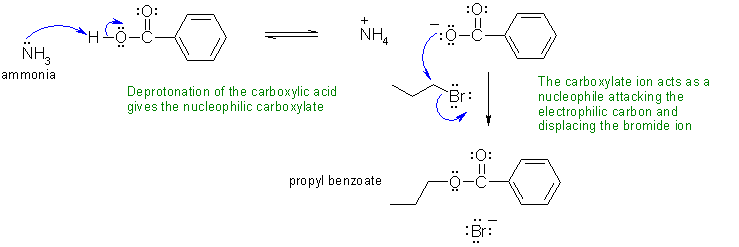
Part 7: MECHANISM
The following diagram shows the solution to the
mechanistic question. Note that all the information applies to a single
reaction sequence that has been completely described verbally.
There is no need for extra reagents or
extra steps etc. The curly arrows are drawn specifically to match the
text in the question. The biggest problem students have is making sure they
understand the language of chemistry. Most students have trouble because they
can't draw the structures from the IUPAC names (that means they don't know their
nomenclature well enough). Read the words carefully, and then make the curly
arrows tell that same story. There is NO need for extra steps. Remember
curly arrows go from electron rich to poor and to balance the
formal charges at each step - errors on formal charges were common.
a.

If you struggled with this part of the question, first draw the compounds whose names were provided, then think about the types of reactions (e.g. acid / base) and try to fill in the structures in the gaps, then finally add the required curly arrows to account for all the bonding changes.
b. Hydroxide (HO-) or an alkoxide (RO-) would be the best choices since their pKa's (about 15) mean that they are certainly strong enough to deprotonate a carboxylic acid (pKa = 5).
c. Since we are making another benzoate ester, we still use benzoic acid but now with 2-bromopropane:

d. This time we need to make an ether, so use phenol with 1-bromopropane but use a stronger base (since the phenol is less acidic):

e. A phenol is less acidic than a carboxylic acid (pKa's 10 and 5 respectively). We can explain this by looking at the conjugate bases of each system. In a carboxylic acid, the -ve charge sits on an electronegative oxygen atom and there is resonance that delocalises the -ve charge to a second oxygen atom. In a phenol, the -ve charge sits on an electronegative oxygen atom and there is resonance that delocalises the -ve charge to 3 of the carbon atoms in the benzene ring. Therefore the key difference is that the carboxylic acid charge delocalisation to a second electronegative atom gives better charge stabilisation.
Common errors:
a.
b. Poor knowledge of acids and bases e.g. suggesting things like Cl- or HSO4- which are very weak bases.
c & d. Did not use part a as the basis of working out the answer. Only showing one component.
e. Did not know the correct structure for a phenol (e.g. confusing it with a phenyl group). Poor knowledge of acidity. Rationale based on pKa alone, incomplete rationale.